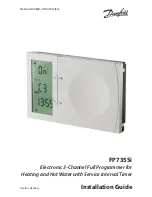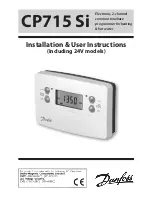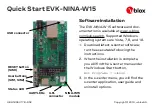
8
QUICK CONNECT FOR THE CONTROL RECEIVER
NOTE:
You do not need to use this input, it is optional, it is only for use with a separate control receiver. If you
do not plan to use a separate control receiver then please skip this page. The repeater receiver port has access to
all the same control functions (the control receiver has priority). Do not connect the repeater receiver to this
input.
1.
If you decide to use a control receiver
you should have the control receiver COS and audio signal already
wired to the proper connections according to the plug layout in this manual before you start. These signals
should be suitable to drive a 100K ohm load.
It is not necessary to use a control receiver to operate the
Linker IIa repeater controller.
2.
Make sure the repeater’s transmitter is disconnected or disabled
3.
Check to see what the COS on and off voltages are and write them down. The difference between them should
be at least 1V and can be somewhat less if the COS voltages are very stable. If a battery is being used to power
the Linker IIa or the receiver, the COS voltages that occur during battery discharge should also be taken into
consideration. In the case of a discharging battery the voltage output from R16 will eventually change as the
battery voltage goes below 10vdc.
4.
Turn the power off
. The control receiver audio input amplifier jumper JP2 setting needs to be determined. For
high gain (about 10 times) do not install the jumper. For a low / normal gain ( about 2 times ) jump
pins 2 & 3. To de-emphasize the audio (discriminator audio) jump pins 1 & 2.
5.
If the COS goes positive when activated make sure the jumpers in JP5 have their skinny parts both faced
towards U2. This is the position for a positive going COS polarity. From the factory the jumpers are set for a
positive polarity (NOTE: Turn the jumpers in JP5 90 degrees for the opposite COS polarity)
6.
If your COS is negative acting make sure the jumpers in JP5 are set so that one jumper has its long side facing
U2. This is the jumper position for a negative going COS polarity.
7.
If the Linker IIa’s control receiver COS input is setup for a positive COS monitor the voltage on pin 12 of U2, if
the Linker IIa’s control receiver is setup for a negative COS monitor the voltage on pin 13 of U2
8.
Adjust R54 (CONTROL RX COS LEVEL POT) until the voltage reading is in the middle of the measured COS
voltage from step 3.
9.
If you have a scope available, monitor the signal on U2 pin 7, if not skip to step 11.
10.
Send a DTMF digit through the control receiver. Set R16 (CONTROL RX AUDIO) until you get about a
200mV reading. You should now see the VALID DTMF LED steadily lit up (no flickering).
11.
If you do not have a scope available start by sending a DTMF digit tone through the control receiver.
12.
Adjust R16 (CONTROL RX AUDIO) until you see the VALID DTMF LED light up. Try to find a center point
so you are not on the edge of operation.
13.
The control receiver should now be ready to perform control functions
Содержание Linker IIa
Страница 12: ...11...










































